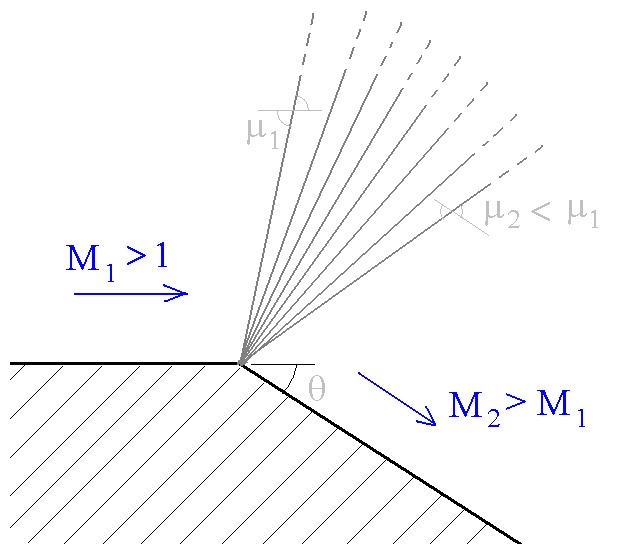 | ||
A supersonic expansion fan, technically known as Prandtl–Meyer expansion fan, is a centred expansion process that occurs when a supersonic flow turns around a convex corner. The fan consists of an infinite number of Mach waves, diverging from a sharp corner. When a flow turns around a smooth, circular corner, these waves can be extended backwards to meet at a point. Each wave in the expansion fan turns the flow gradually (in small steps). It is physically impossible for the flow to turn through a single "shock" wave because this would violate the second law of thermodynamics. Across the expansion fan, the flow accelerates (velocity increases) and the Mach number increases, while the static pressure, temperature and density decrease. Since the process is isentropic, the stagnation properties (e.g. total pressure and total temperature) remain constant across the fan.
Contents
Flow properties
The expansion fan consists of infinite number of expansion waves or Mach lines. The first Mach line is at an angle
The Mach number after the turn (
where,
By convention,
Maximum turn angle
As Mach number varies from 1 to
This places a limit on how much a supersonic flow can turn through, with the maximum turn angle given by,
One can also look at it as follows. A flow has to turn so that it can satisfy the boundary conditions. In an ideal flow, there are two kinds of boundary condition that the flow has to satisfy,
- Velocity boundary condition, which dictates that the component of the flow velocity normal to the wall be zero. It is also known as no-penetration boundary condition.
- Pressure boundary condition, which states that there cannot be a discontinuity in the static pressure inside the flow (since there are no shocks in the flow).
If the flow turns enough so that it becomes parallel to the wall, we do not need to worry about pressure boundary condition. However, as the flow turns, its static pressure decreases (as described earlier). If there is not enough pressure to start with, the flow won't be able to complete the turn and will not be parallel to the wall. This shows up as the maximum angle through which a flow can turn. The lower the Mach number is to start with (i.e. small
The streamline which separates the final flow direction and the wall is known as a slipstream (shown as the dashed line in the figure). Across this line there is a jump in the temperature, density and tangential component of the velocity (normal component being zero). Beyond the slipstream the flow is stagnant (which automatically satisfies the velocity boundary condition at the wall). In case of real flow, a shear layer is observed instead of a slipstream, because of the additional no-slip boundary condition.
